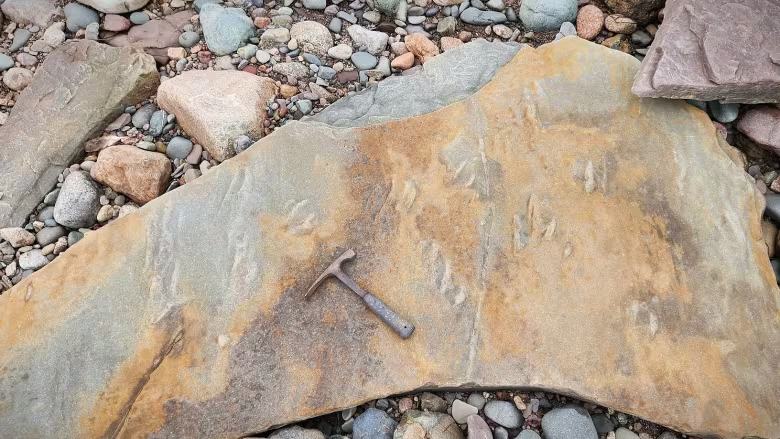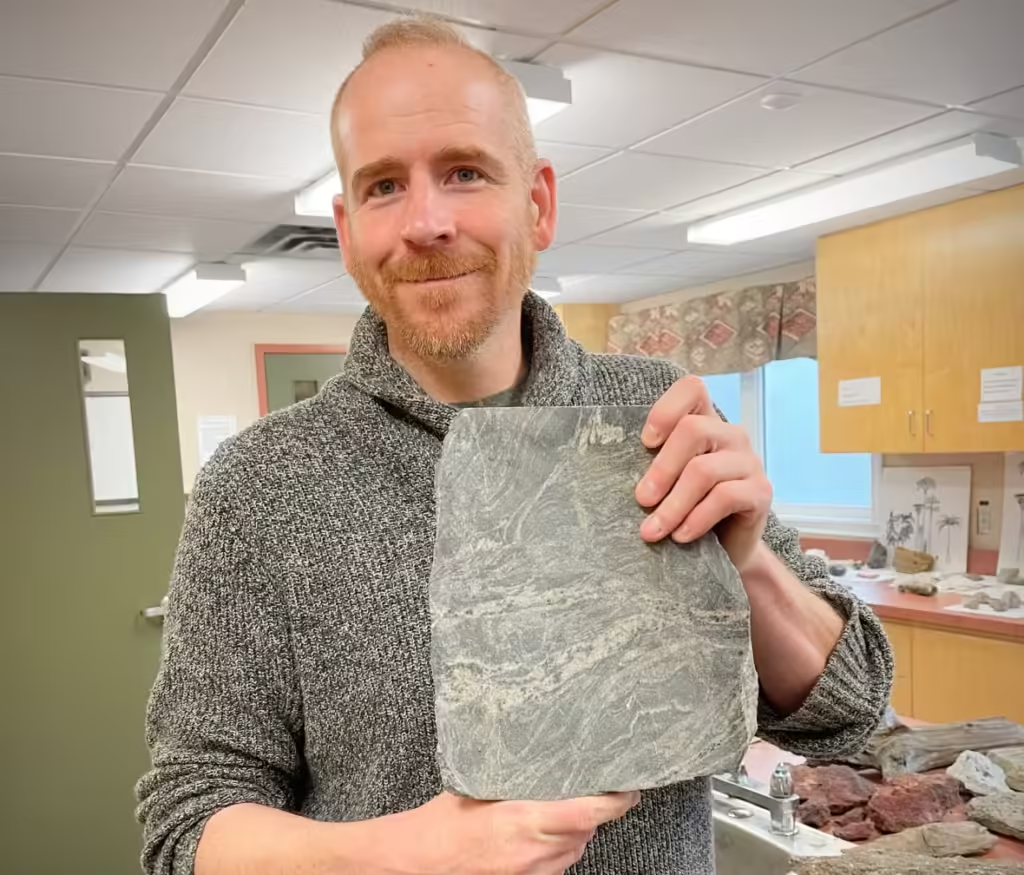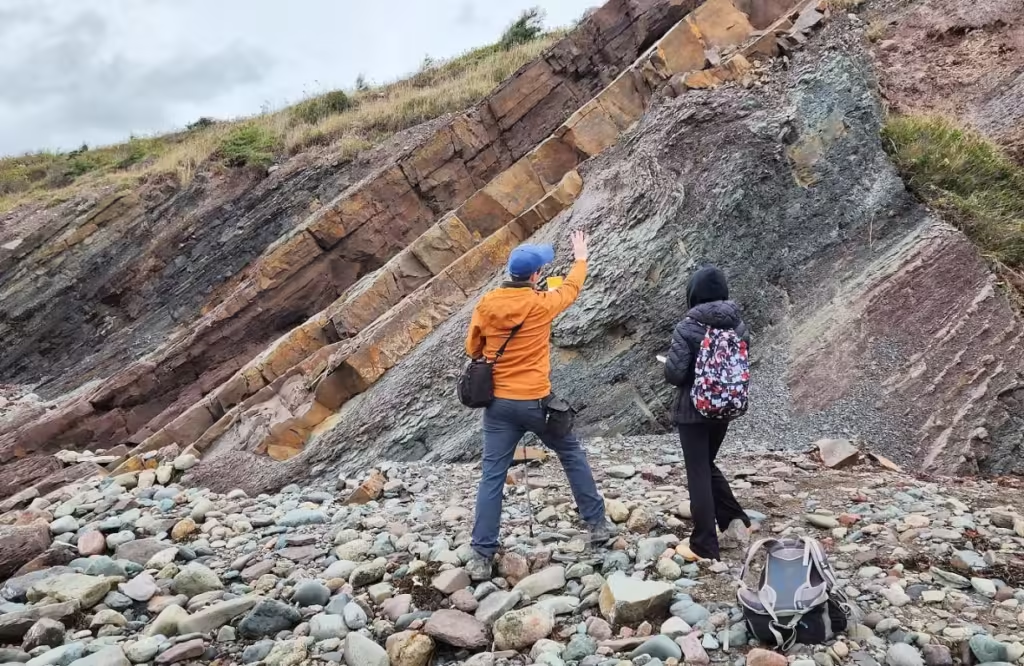People are flocking to see a remarkable new exhibit featuring 320-million-year-old footprints at the Cape Breton Fossil Centre in Sydney Mines, Nova Scotia. The footprints, discovered by a team of geologists from Cape Breton University (CBU), have garnered significant attention due to their impressive size and ancient origin. This discovery has provided valuable insights into the region’s prehistoric ecosystem and its inhabitants.

The fossilized claw imprints were discovered by chance in November when geologist Ted Matheson and a student were conducting unrelated research on sedimentary structures associated with earthquakes near Creignish, Inverness County. While examining the area, Matheson noticed what appeared to be footprints and sent a picture of the unusual markings to Jason Loxton, a senior geology instructor at CBU and curator of the Cape Breton Fossil Centre. Loxton, initially skeptical, dismissed the discovery. However, upon visiting the site the following day and seeing the footprints in person, he realized their significance.
“Typically, fossils we find in Cape Breton and Nova Scotia range from less than a centimeter to a few centimeters,” Loxton explained. “These particular imprints are as large as an adult man’s hand, with fingers slightly spread out. This is a significant find.” The size and clarity of the footprints set them apart from other fossils discovered in the region, making them a subject of great interest to both scientists and the public.
Loxton then forwarded a picture of the imprints to Matt Stimson, a paleontologist at the New Brunswick Museum. Stimson immediately recognized the markings as footprints, confirming their importance. “This is a rare find in Atlantic Canada since most Mississippian period rocks are buried under Carboniferous period material,” Stimson noted. The footprints, dating back to the Mississippian period, provide a unique glimpse into a time when the region’s landscape was vastly different from today.

Stimson further explained that the tracks likely belong to an anthracosaur, a transitional creature between amphibians and reptiles. This makes the discovery particularly important as it offers new evidence about the types of animals that inhabited the area during that time. “We don’t know the exact animal that made these tracks, but given the time period, the size, and the shape of the feet, we can say it’s probably something called an anthracosaur,” Stimson said. “To find the largest footprint from that time period that we know of so far, the apex predator, is a really significant discovery.”
Loxton described the fossil as resembling the marks left by a crocodile-like animal swimming in shallow water. “Imagine dragging your fingertips lightly across mud, creating a series of parallel lines. That’s what these imprints look like,” he said. The discovery suggests that large, crocodile-like creatures once roamed the area, adding a new dimension to our understanding of the prehistoric ecosystem in Cape Breton.
Most surface rocks in Cape Breton are from the end of the Carboniferous period, a time characterized by dense tropical swamps. This environment supported a wide range of plant and animal life, creating ideal conditions for fossil preservation. However, rocks from the Mississippian period, which preceded the Carboniferous, are less commonly found exposed on the surface. Creignish is one of the few locations where Mississippian period rocks are accessible, making it a valuable site for paleontological research. While footprints are occasionally discovered in this area, none have been as large or as well-preserved as the recent find.

Loxton emphasized that many significant fossils are discovered by chance, often by individuals who are not professional paleontologists. “The reality is almost all of the important fossils we study were found by accident, often by a non-paleontologist, and this is exactly the same case,” he said. The footprints are embedded in a sandstone block measuring 15 centimeters thick, two meters long, and one meter wide. This substantial size presents challenges for transporting the fossil to the Cape Breton Fossil Centre.
Despite these challenges, the fossil centre has obtained a permit to add the footprints to its collection. If the sandstone block proves too heavy to move, Loxton plans to take detailed photographs and create a 3-D model of the imprints for further study and display. This approach will allow researchers and visitors to examine the footprints closely, preserving their scientific and educational value.
The discovery of these ancient footprints has sparked excitement and curiosity among both the scientific community and the general public. Visitors to the Cape Breton Fossil Centre have the opportunity to view the footprints up close and learn about the prehistoric creatures that once roamed the area. The exhibit provides a tangible connection to the distant past, offering a fascinating glimpse into the ancient world.
This discovery highlights the importance of preserving and studying fossil sites, as they offer invaluable insights into the history of life on Earth. It also underscores the significance of interdisciplinary collaboration in scientific research. The partnership between geologists, paleontologists, and other experts has been crucial in uncovering and interpreting the footprints, demonstrating the power of teamwork in advancing our understanding of the natural world.
In conclusion, the discovery of 320-million-year-old footprints at the Cape Breton Fossil Centre is a significant and exciting find that sheds new light on the prehistoric ecosystem of Nova Scotia. The size and clarity of the imprints, along with their rare age, make them a valuable addition to the scientific community’s understanding of the Mississippian period. As researchers continue to study the footprints and share their findings with the public, this remarkable discovery will inspire awe and curiosity for years to come.
SOURCE OF NEWS :- CBC